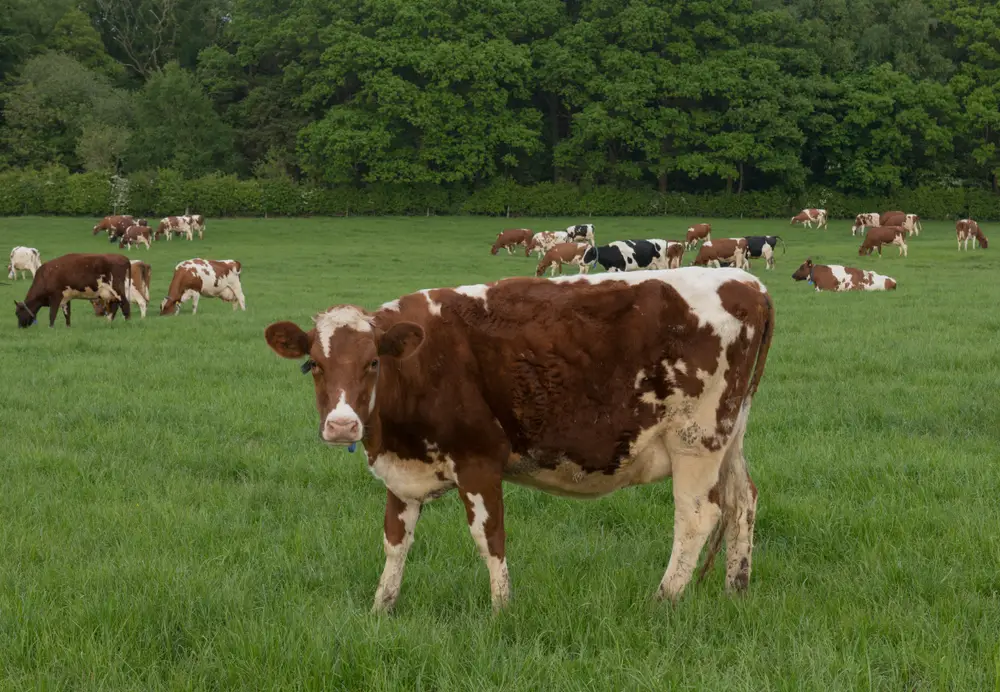Ayrshire cattle are a Scottish dairy breed of cattle known to be efficient grazers and are praised for their hardiness. They are also prolific milk producers, with owners yielding up to 20,000 pounds of milk during the lifetime of just one cow.
Today, the Ayrshire is known worldwide and has registration associations in Canada, New Zealand, and the United States.
Table of Contents
Where Does Ayrshire Cattle Come From?
Ayrshire cattle are native to the district of Cunningham in the county of Ayr in Scotland.
They were first established in the 18th century when native Scottish cattle were crossbred with Teeswater cattle.
Teeswater cattle have been used in the development of several breeds including the Shorthorn breed in the United Kingdom, and the Holstein breed in Holland.
The infusion of Teeswater blood allowed the poor milk-producing breeds of Scotland to improve milk production in their native dairy cattle.
Ayrshire cows have been called Dunlop cows, and Cunningham cows but their name was changed to reflect the county of Ayr when they were first recognized by the Highland Agricultural Society in 1814, and subsequently had a herd book created for them in 1877.
In 1822 the first importations to America occurred and they were shipped to New England, with Ayrshire herds being established in New York, Vermont, New Jersey, and Pennsylvania.
Americans were slow to recognize the Ayrshire breed, but dairy farmers continued to promote the Ayrshire, and cleverly marketed Ayrshire milk by establishing the Ayrshire Breeder’s Association which created the Approved Ayrshire Milk program in the 1930s. The program promoted Ayrshire milk as healthier and better for children and was wildly successful.
Ayrshire Cattle Breed Characteristics
| Official Breed Name | Ayrshire Cattle |
| Scientific Name | Bos (primigenius) taurus |
| Origin | Scotland |
| Appearance | Red and White spotted. Brindle and roan coloring is rare. |
| Calf Weight | 75lbs to 88lbs |
| Mature Cow Weight | 1000lbs to 1200lbs |
| Mature Cow Height | 4.5 feet |
| Mature Bull Weight | 1200lbs to 1500lbs |
| Mature Bull Height | 4.7 feet |
| Ready To Breed | 13 to 15 months |
| Gestation Period | 283 days |
| First Calvings | 2 years |
| Time to Slaughter | 6 to 9 months, though 12 months is best |
| Carcass Weight | 698lbs on average |
| Expected Lifespan | Up to 20 years in free-ranging farms |
| Productive Lifespan | 4-6 years in commercial setups |
| Known For | Feed efficiency turning grass into milk, low mastitis counts, longevity, good temperament |
| Weaknesses | Lower butterfat content and less milk production when stressed |
| Climate | Able to adapt to many different climates reasonably well but don’t do well in extremely hot and humid climates |

What Is So Special About Ayrshire Cattle?
Ayrshire cows are best known for their milk and they are the top choice for cheese production in the United States.
The average milk output for Ayrshire dairy cows is 20,000 pounds of milk throughout their life. They have a lactation period of 305 days.
They are well known as efficient grazers and cattle that are adaptable to different farming methods.
Why Should I Raise Ayrshire Cattle On My Farm?
- Ayrshires are known for excellent udder conformation
- They do not have excessive leg problems and foot problems
- Adaptable to different terrain and able to forage well
- Can adjust to warm and cold climates
- Ayrshire’s lack the yellow tallow that reduces carcass valuation
- It is profitable to raise Ayrshire bull calves to steers
- Developed as a profitable commercial dairy cow and still widely used as such
- Calves are strong, vigorous, and easy to raise
